Nelsons brings thoughtful individuality to Brahms with BSO

Andris Nelsons conducted the Boston Symphony Orchestra Tuesday night at Symphony Hall. Photo: Winslow Townson
Traditionally, the Boston Symphony Orchestra’s Thanksgiving week program isn’t too unlike the meal itself: safe, comforting, familiar. There is nothing wrong with that, of course, since such events are easy to rehearse, economically viable, and, typically, musically satisfying.
Such was certainly the case with this year’s all-Brahms fest at Symphony Hall. To judge from Tuesday night’s performance of the Serenade No. 2 and Symphony No. 1, both led by music director Andris Nelsons, it’s particularly salubrious for the orchestra: they’re reveling in their first crack at Brahms in nearly two years.
To be sure, Nelsons’ conception of the symphony lacked some of the sweep and organic logic of Herbert Blomstedt’s gripping account from 2019.
Yet Nelsons’ reading revealed its own strengths. Chief among them is its seeming intention to upend Edward Lorne’s pithy assessment of the Brahms symphonies: they supposedly remind, Lorne wrote, that “art is long and life is short.”
Not so this week. Tuesday’s account of Brahms One was purposefully driven and discreetly detailed. The first movement was compellingly shaped, tonally and architecturally. Nelsons drew a velvety sound from the ensemble over the introduction and start of the exposition. But this ceded, as things unfolded, to playing of a rawer, more purely energetic kind.
Along the way, Nelsons illuminated subtleties and colors in the scoring that are often passed over, like the attractive shimmer of the string tremolos at the start of the development and the blend of woodwind and brass swells near its end. Similarly striking were the menacing horn-and-timpani exchanges that unfolded underneath the movement’s otherwise-radiant coda.
In the Andante, the BSO’s richly blended textures always functioned as a plush support for the musical line. Conversely, the third was more drab than glowing, yet its essentially sweet, playful character came across, especially in the outer thirds.
Nelsons’ take on the finale was a mix of elements from his thoughtful approach. The jagged introduction was duly portentous, and, though one missed the antiphonal effect of violin sections playing across the podium, the horn-and-flute prelude to the strings’ hymn-like theme gleamed.
At the same time, the movement’s initial climaxes were texturally blunt, the development often sounding dutifully—rather than of necessity—stormy. But balances and character improved as the piece headed towards its denouement. The coda, perhaps not as hard-won as some, blazed triumphantly all the same.
While the larger reading wanted for some finesse—solo balances in the second movement were dicey, the third was blurry and tended to rush—it revealed Nelsons as an increasingly persuasive advocate for this piece. Indeed, the conductor skillfully underlined several of the score’s motivic cells and stylishly tied together the symphony’s outer movements.
He was further in his element with the charming A-major Serenade. Completed in 1859, when Brahms was in the early stages of his career, this is music of unaffected lyricism and beauty. Tuesday’s performance didn’t try to make any more of it than that; the result was a reading of infectious joy.
The first of the Serenade’s five movements flowed smartly, its dynamic structure attentively shaped and its busy textures both well-blended and distinctly projected.
The playful Scherzo snapped, its swaggering coda presenting a mighty contrast with the Adagio’s soberly floating woodwind melodies and strongly diverging thematic material. In the Minuet, Nelsons drew a darkly lilting reading from his forces, highlighted by a hushed, mysterious Trio.
Though the bewitching finale suffered from moments of tentative ensemble, its winsome refrain soared, culminating in an electrifying, piccolo-led coda.
The program will be repeated 1:30 p.m. Friday and 8 p.m. Sunday at Symphony Hall. bso.org; 888-266-1200
Posted in Performances




